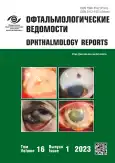The options of an individual approach to the modification of sinustrabeculectomy for hypotensive effect prolongation
- Authors: Suleiman E.A.1, Petrov S.Y.1
-
Affiliations:
- Helmholtz National Medical Research Center of Eye Diseases
- Issue: Vol 16, No 1 (2023)
- Pages: 17-26
- Section: Original study articles
- URL: https://journal-vniispk.ru/ov/article/view/144100
- DOI: https://doi.org/10.17816/OV256670
- ID: 144100
Cite item
Abstract
BACKGROUND: Reducing scarring in the postoperative period is one of the main tasks of glaucoma surgery.
AIM: To develop new modifications of sinustrabeculectomy in the surgical treatment of primary open-angle glaucoma normalizing and prolonging the outflow of aqueous humor along newly formed pathways.
MATERIALS AND METHODS: Surgical procedures were performed in 106 patients (109 eyes) with primary open-angle glaucoma of moderate and advanced stages, without any history of previous surgeries. Patients were divided into groups: 1a — 25 patients (25 eyes) who underwent sinustrabeculectomy with the formation of grooves for the intramuscular fluid outflow, 1b — 26 patients (28 eyes) who underwent of sinustrabeculectomy with scleral flap twisting, 1c — 28 patients(29 eyes) who underwent sinustrabeculectomy with scleral flap stitching, and the control group — 27 patients (27 eyes) who underwent routine sinustrabeculectomy. The follow-up duration was up to 24 months.
RESULTS: In 1 month after surgery, the average level of intramuscular pressure was comparable and remained low in all groups. Complete compensation of intramuscular pressure in groups 1a, 1b and 1c was observed in 80%, 75% and 76% of cases; partial — in 16%, 18% and 21% of cases; failure — in 4%, 7% and 3% of cases, respectively. In the control group (2), complete hypotensive success was noted in 55% of cases; partial — in 30% of cases; failure — in 15% of cases.
CONCLUSIONS: Developed new methods of sinustrabeculectomy allow to obtain a prolonged hypotensive effect.
Full Text
##article.viewOnOriginalSite##About the authors
Elena A. Suleiman
Helmholtz National Medical Research Center of Eye Diseases
Author for correspondence.
Email: elena-548@inbox.ru
ophthalmologist
Russian Federation, MoscowSergey Yu. Petrov
Helmholtz National Medical Research Center of Eye Diseases
Email: glaucomatosis@gmail.com
Dr. Sci. (Med.), head of Glaucoma Department
Russian Federation, MoscowReferences
- Kozlova IV, Akopyan AI, Reshikova VS. Efficacy of the combined therapy in patients with primary open angle glaucoma. National Journal glaucoma. 2011;10(3):25–29. (In Russ.)
- Cairns JE. Trabeculectomy. Preliminary report of a new method. Am J Ophthalmol. 1968;66(4):673–679. doi: 10.1016/0002-9394(68)91288-9
- Francis BA, See R, Rao N, et al. Ab interno trabeculectomy: development of a novel device (Trabectome) and surgery for open-angle glaucoma. J Glaucoma. 2006;15(1):68–73. doi: 10.1097/01.ijg.0000196653.77836.af
- Saheb H, Ahmed IK. Micro-invasive glaucoma surgery: current perspectives and future directions. Curr Opin Ophthalmol. 2012;23(2):96–104. doi: 10.1097/ICU.0b013e32834ff1e7
- Petrov SIu, Vostrukhin SV, Aslamazova AE, Sherstneva LV. Modern methods of minimally invasive glaucoma surgery. The Russian Annals of Ophthalmology. 2016;132(3):96–102. (In Russ.) doi: 10.17116/oftalma2016132396-102
- Astakhov YuS, Egorov EA. Surgical treatment of refractory glaucoma. Russian journal of clinical ophthalmology. 2006;7(1):25–27. (In Russ.)
- Batmanov YuE, Evgrafov VYu, Guliev FV. Modern aspects in glaucoma surgery. Vestnik Oftalmologii. 2008;124(4):53–56. (In Russ.)
- Artamonov VP. Ehffektivnost subskleralnoi sinusotomii pri glaukome. The Russian Annals of Ophthalmology. 1980;(2):5–8. (In Russ.)
- Babushkin AEh. Modifikatsiya sinusotomii. The Russian Annals of Ophthalmology. 1991;107(5):7–9. (In Russ.)
- Watson PG, Barnett F. Effectiveness of trabeculectomy in glaucoma. Am J Ophthalmol. 1975;79(5):831–845. doi: 10.1016/0002-9394(75)90745-X
- Watson PG. Trabeculectomy: A modified ab externo technique. Ann Ophthalmol. 1970;2:199–206.
- Krasnov MM, Kolesnikova LN. Trabekuloehktomiya v sisteme khirurgicheskogo lecheniya glaukomy. The Russian Annals of Ophthalmology. 1969;112(6):54–57. (In Russ.)
- Krasnov MM. Microsurgery of glaucoma. Indications and choice of techniques. Am J Ophthalmol. 1969;67(6):857–864. doi: 10.1016/0002-9394(69)90079-8
- Nesterov AP, Federova NV, Batmanov YE. Sinus trabeculectomy. Preliminary results of 100 operations. Br J Ophthalmol. 1972;56(11):833–839. doi: 10.1136/bjo.56.11.833
- Yerichev VP, Bessmertniy AM, Chervyakov AYu. Polnost’yu fistuliziruyushchaya operatsiya kak sposob povysheniya ehffektivnosti khirurgicheskogo lecheniya refrakternoi glaukomy. Russian Journal of Clinical Ophthalmology. 2002;(2):59. (In Russ.)
- Zhuravleva AN, Suleiman EA, Kiseleva OA. Surgical method for prevention of scaring in conducting sinustrabeculectomy. Saratov journal of medical scientific research. 2017;13(2):372–375. (In Russ.)
- Agarwal HC, Sharma TK, Sihota R, Gulati V. Cumulative effect of risk factors on short-term surgical success of mitomycin augmented trabeculectomy. J Postgrad Med. 2002;48(2):92–96.
- Briggs MC, Jay JL. Age over 46 years does not affect the pressure lowering effect of trabeculectomy in primary open angle glaucoma. Br J Ophthalmol. 1999;83(3):280–284. doi: 10.1136/bjo.83.3.280
- Mietz H, Krieglstein GK. Suramin to enhance glaucoma filtering procedures: a clinical comparison with mitomycin. Ophthalmic Surg Lasers. 2001;32(5):358–369. doi: 10.3928/1542-8877-20010901-03
- Broadway DC, Chang LP. Trabeculectomy, risk factors for failure and the preoperative state of the conjunctiva. J Glaucoma. 2001;10(3):237–249. doi: 10.1097/00061198-200106000-00017
- Khairy HA, Elsawy MF. Trabeculectomy with Mitomycin-С versus trabeculectomy with amniotic membrane transplant: A medium-term randomized. Controlled trial. J Glaucoma. 2015;24(7):556–559. doi: 10.1097/IJG.0000000000000060
- Lebedev OI. Kontseptsiya izbytochnogo rubtsevaniya tkanei glaza posle antiglaukomatoznykh operatsii. The Russian Annals of Ophthalmology. 1993;109(1):36–39. (In Russ.)
- Starita RJ, Fellman RL, Spaeth GL, et al. Short- and long-term effects of postoperative corticosteroids on trabeculectomy. Ophthalmology. 1985;92(7):938–946. doi: 10.1016/S0161-6420(85)33931-3
- Alekseev IB, Koshcheeva EA. Metod khirurgicheskogo lecheniya patsientov s subkompensirovannoi i nekompensirovannoi glaukomoi, ranee perenesshikh fistuliziruyushchuyu operatsiyu. Glaukoma. 2007;(1):27–31. (In Russ.)
- Shmyreva VF, Petrov SIu, Antonov AA, Pimenidi MK. Controlled cytostatic therapy in the early periods after surgery for glaucoma: preliminary results. The Russian Annals of Ophthalmology. 2007;123(1):12–14. (In Russ.)
- Wilson RP, Steinmann WC. Use of trabeculectomy with postoperative 5-fluorouracil in patients requiring extremely low intraocular pressure levels to limit further glaucoma progression. Ophthalmo logy. 1991;98(7):1047–1052. doi: 10.1016/S0161-6420(91)32178-X
- Suleiman EA, Petrov SYu. New techniques of sinus trabeculectomy with prolonged hypotensive effect. Russian Ophthalmological Journal. 2022;15(3):61–66. (In Russ.) doi: 10.21516/2072-0076-2022-15-3-61-66
Supplementary files













